INTRODUCTIONThere are three types of phones used to investigate audibility thresholds, both for pure tone and speech signs in audiological practice (Zwislocki et al., 1988), varying in advantages and limitations.
Supra-aural phones - the cushion of the phones is pressed against the pinna. They are the conventional phones in audiology.
Circumaural phones - the cushion of the phones is around the pinna, instead of against it. They are little used in audiology because of lack of calibration standards.
Insert phones - they are adapted in the external acoustic canal with disposable foam plugs, reducing the area of the head exposed to sound stimuli (pure tone, speech, masking noise).
According to Zwislocki (1953), interaural attenuation for air conduction stimuli is inversely proportional to the surface exposed to the mechanical/ acoustic force. With insert phones, the vibrating area is smaller, resulting in reduction of air conduction signal intensity, transmitted through the cranial bones to the contralateral cochlea. Consequently, there is increased interaural attenuation for air conduction stimuli.
Therefore, the development of insert phones has contributed to solve, or at least minimize, the problem related to overmasking and insufficient masking, especially in cases of bilateral conductive hearing loss.
Insert phones have been used in audiology for more than four decades. One of the first studies published in the literature about this kind of transducer was written by Von Bekesy in 1948.
Since then, different manufacturers developed different types of insert phones. In 1984, Killion combined a network of electrical equalization, one acoustic maximum output hearing aid receptor, a coupling tube with carefully defined acoustic delay and a foam plug, to adapt the transducer to the external acoustic canal. It was created the insert phone (ER-3 A), which was later manufactured and marketed by Etymotic Research and became the most commonly used insert phone in daily practice (Silman and Silverman, 1997).
In the study by Clemis et al. (1986), the authors reported that ER-3A insert phones were created to mimic the frequency response of supra-aural TDH-39 phones, clarifying that audibility thresholds obtained with both phones may be compared, provided that the correction factor is applied for frequencies 125, 250, 6000 and 8000 Hz.
In 1988, Wilber et al. published the temporary reference thresholds for insert phones ER-3 A compared with supra-aural phones and reported great compatibility among the results obtained from both transducers.
Lilly and Purdy, in 1993, published an article listing advantages and potential problems that could derive from the exclusive use of insert phones. Among the advantages, they mentioned reduction of environmental noise masking effect, increase in interaural attenuation both for pure tone and masking sounds, and the exclusion of occlusion effect. Less durability, need to use correction factors if insert phones were not the default transducers of the system, and impact of different external acoustic canal shapes were some of the problems listed.
In a number of audiology centers in the US, insert phones ER-3 A have been used as routine for more than 10 years, both for behavioral assessment (pure tone and speech audiometry) and electrophysiological measures (ABR, long and middle latency potentials) (Wilber, 1999).
Nevertheless, we did not find any study involving this kind of transducer in Brazil.
Based on these premises, the purposes of the present study were:
To compare audibility thresholds for pure tone obtained with supra-aural TDH-39 phones, and insert phones ER-3 A in both male and female audiologically normal subjects.
To check the applicability of correction factors proposed by the manufacturer by comparing the responses obtained with both transducers.
MATERIAL AND METHODWe evaluated 40 young adults - 20 male subjects aged 16 to 35 years (mean age = 23.6 years) and 20 female subjects aged 20 to 34 years (mean age = 22.7 years), with no hearing complaints.
The population that participated in the present study was selected and assessed at the Ambulatory of Speech and Hearing Pathology, Discipline of Hearing Disorders at Universidade Federal de São Paulo - Escola Paulista de Medicina.
The subjects were submitted to external acoustic canal inspection and later to basic audiological assessment comprising pure tone audiometry, speech discrimination (speech reception thresholds - SRT and percentage speech recognition index - PSRI), and immitance measures - tympanometry, static compliance and contralateral middle ear acoustic reflex, according to the criteria defined by Mangabeira Albernaz et al. (1981).
Audiological assessment (pure tone and speech discrimination) were performed in a sound booth, using Maico MA-41 audiometer, calibrated according to ANSI 1969, with the supra-aural TDH-39 phones adapted at MX41 cushions. Later, the same procedures were repeated with the insert phones ER-3 A at 10 ohms impedance. The audiometer used was calibrated according to the standards provided for the supra-aural phones. However, as reported by Valente et al. (1994), both transducers may be used by the same piece of equipment, provided that the frequency correction factor is applied with the insert phone ER-3 A.
CHART 1 - Correction factors (to be added) as suggested by the manufacturer for the frequency range 125 to 8000 Hz.

The device Interacoustics Damplex AZ 7 with phones TDH-39, cushion MX 41, and 226 Hz probe tone was used to perform acoustic immitance measures.
The insert phone produces sound vibration in a loudspeaker that is separated from the portion inserted in the external acoustic canal by a relatively long plastic tubing (approximately 278 mm). The contact between the phone and the skin is very limited and the amount of vibration transferred from the phone to the skull is minimal. Supra-aural phones are more in contact with the skin surface, reducing the quantity of interaural attenuation and increasing the risk of lateralization (Stach, 1998).
Phones consist of two rectangular 5x4x1 cm plastic boxes. Each box has a specific plastic tube coupled to the basis and it contains one receptor, two acoustic filters, one cancellation electrical net and one "cancellation Carlson tube". During use, the plastic boxes are tied to the patient's clothes and the foam plugs are adapted at the tip of each tube and inserted into the external acoustic canal (Clark and Roeser, 1988).
Insert phones have the following components:
Transducer, responsible for conversion of sound energy into acoustic energy.
Conductor, plastic tubing that takes the sound into the external acoustic canal.
Coupler, a means through which the phone is adapted to the external acoustic canal.
In the present study, insert phones ER - 3 A were adapted to the external acoustic canal with disposable foam plugs manufactured with PVC, branded E-A-RLINKTM which were selected according to the opening of the acoustic canal of each subjects.
Based on the manufacturer's recommendations, in order for the phone to have the ideal performance, the insertion of the plug should be deep (2-3 mm) to ensure total insertion position of approximately 16 mm deep, measured from the pinna.
In order to correlate hearing thresholds obtained with supra-aural and insert phones, in devices calibrated from conventional phones, the manufacturer proposes the use of correction factors to be added to the recordings made in the audiometer. The correction factors are shown in Chart 1.
Although we did not consider the correction factor as we recorded the audiometric responses, in the statistical analysis of the data we applied them to in order to check applicability in the population studied here.
The results of auditory thresholds obtained for the frequency range 250 to 8000 Hz were analyzed and compared, taking into consideration variables such as gender, ear and type of transducer (with and without correction factor).
For the statistical analysis of results we used nonparametric Mann-Whitney and Wilcoxon tests and we defined significance level of 5% or 0.05. Statistically significant values were marled with asterisk.
RESULTS AND DISCUSSIONAudibility thresholds obtained with both supra-aural TDH-39 phones and insert phones ER-3A, were within normal ranges (below 25 dB HL), bilaterally, in all studied subjects.
However, by observing Tables 1 and 2 we noticed that with insert phones there were lower thresholds in frequencies 250, 500, 1000, 2000, 3000 and 4000 Hz, and higher thresholds in 6000 and 8000 Hz than with the supra-aural phones, for both genders.
Zwislocki et al. (1988) suggested in his article about Phones in the Audiologic practice that insertion phones did not present dynamic range or sufficient potency, especially in high frequencies. Confirming this statement, Valente et al. (1992) reported that to determine high frequency thresholds, stimulus intensity should be louder with insert phones than with conventional supra-aural phones.
A possible explanation could be the higher attenuation of external noise, caused by insert phones. The advantages of this kind of transducer was reported by various authors: Killion and Villchur, 1988; Clemis Ballad and Killion, 1986; Wilber et al., 1988; Borton et al., 1989; Berger and Killion, 1989; Frank and Wright, 1990; Lilly and Purdy, 1993; Frank and Williams, 1993; Mueller and Hall, 1997; Wilber, 1999; Sanders and Hall, 1999.
TABLE 1 - Mean values (mean and standard deviation) of audibility thresholds obtained with supra aural phones TDH-39 in 40 subjects, 20 males and 20 females, and the results of Mann-Whitney statistical test.
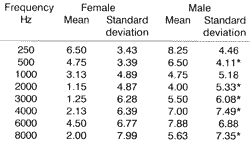
Mann Whitney Test
*p<0.05or5%
TABLE 2 - Mean values (mean and standard deviation) of non-corrected audibility thresholds, obtained with insert phones ER-3A in 40 subjects, 20 females and 20 males, and the results of Mann-Whitney statistical test.
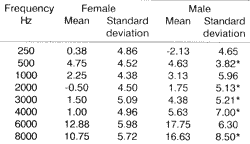
Mann Whitney Test
*p<0.05or5%
Therefore, supra-aural phones seem to be more susceptible to external noise influence, surpassed by both insert phones and circumaural phones (Stein and Zerlin, 1966; Shaw, 1966; Bienvenue and Michael, 1978; Berger and Killion, 1989; Frank and Wright, 1990). However, the main contraindication for the use of circumaural phones is the absence of reliable calibration methods (Tillman and Gish, 1966; Benson et al., 1967). Thus, insert phones are the most indicated type of transducer to be used in pure tone audiometry, especially if environmental noise is preponderant, since it provides attenuation of external noise and there are known and reliable calibration methods (Wilber, 1994).
In Tables 1 and 2 we noticed statistically significant difference among male and female subjects, both for thresholds determination with TDH-39 and insert phones ER-3 A. Except for frequency 250 Hz, when tested with insert phone, women presented lower auditory thresholds than men.
We did not find literature studies that had obtained similar data nor any reason that would justify this gender difference.
The literature is full of reports concerning the variables that may interfere the determination of insert phones thresholds, without mentioning the gender variable. Individual differences in geometry of the external acoustic canal, type of coupling and depth of insertion are referred.
Individual differences of external acoustic canal volume may increase variability of responses with insert phones, especially for pure tones (Cox and McDaniel, 1986). Other authors mention the variability in the geometry of the external auditory canal as a disadvantage of insert phones (Zwislocki et al., 1988; Larson et al., 1988; Valente et al., 1994; Goldstein and Newman, 1994).
Considering the existing differences between size and geometry of external acoustic canal in men and women, we could expect some differences in thresholds obtained with insert phones. In addition, if we consider that the external acoustic canal in women is smaller and shorter than in men, we could infer that the residual space of the external acoustic canal after the insertion of a foam plug is more reduced in women, which would contribute to reducing the amount of physiological noise in the space, and 4consequently, it would enable the detection of lower thresholds, as suggested by Larson et al., 1988.
The insertion depth of the plug in the external acoustic canal plays a key role in maximizing the advantages offered by the insert phones. There are innumerous studies that suggested the difficulty to monitor insertion depth and reach the recommended "deep insertion", but interferes in the results, both because of inter-subject variability and comparison of one study to the other, in addition to interfering in the magnitude of inter-aural attenuation provided by this kind of transducer (Hosford-Dunn et al., 1986; Cox and McDaniel, 1986; Clark and Roeser, 1988; Berger and Killion, 1989; Frank and Williams, 1993; Yantis, 1994; Munro and Agnew, 1999).
TABLE 3 - Mean values (mean and standard deviation) of non-corrected audibility thresholds, obtained with supra aural TDH-39 phones and insert phones ER-3A in 20 male subjects.
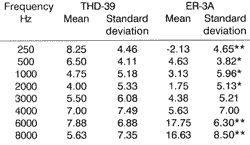
Wilcoxon Test
*p < 0.05 or 5%
**p < 0.01 or 1%
TABLE 4 - Mean values (mean and standard deviation) of non-corrected audibility thresholds obtained with supra aural TDH-39 phones and insert phones ER-3A in 20 female subjects.

Wilcoxon Test
* p < 0.05 or 5%
** p < 0,01 or 1%
In the present study, the examiner has carefully followed the instructions of the manufacturer concerning insertion depth of the foam plug, and we may state that we managed to have deep insertion in most of the studied subjects. Nevertheless, "depth" could not be objectively measured and it has certainly varied at least a bit from subject to subject.
In Tables 3 and 4, we observed the mean values of thresholds obtained with supra-aural phones and insert phones without the application of the correction factor suggested by the manufacturer. We noticed statistically significant differences for both genders, showing the need to apply the correction factor and the impossibility of having a direct comparison of thresholds obtained with the two types of transducer, a fact already confirmed by different authors (Wilber et al., 1988; Borton et al., 1989; Lindgren, 1990; Frank and Vavrek, 1992; Valente et al., 1997).
In Tables 5 and 6 we observed that even with the recommended correction, there were statistically significant differences for both genders. Based on this finding, we calculated correction values that were capable of defining correspondence among the thresholds obtained with different transducers. Owing to gender differences, the values of correction were separated for men and women, as demonstrated in Chart 2.
Upon comparing the corrections suggested by the present study and by the manufacturer (Chart 1), we observed that frequencies 1000 and 3000 Hz did not need correction, as suggested by the manufacturer, and frequency 250 Hz in males required more correction than the recommended amount.
In frequencies 500, 1000 and 2000 Hz for males and 2000 Hz for females, we observed that the value suggested for the study had not statistical validity from a clinical standpoint, since thresholds search is performed by using 5 dB increments. For frequencies 4000, 6000 and 8000 Hz, for both genders and frequencies 250 and 500 Hz for females, the correction factors suggested by the present study corresponded exactly to the recommendation by the manufacturer.
Despite some minor differences, we may state that our overall data confirmed the need and suitability of correction factors suggested by the manufacturer.
CONCLUSIONSBased on the clinical analysis of results of audibility thresholds obtained with supra-aural and insert phones, conducted at the Ambulatory of Hearing Disorders, Universidade Federal de São Paulo in audiologically normal subjects, we concluded that:
TABLE 5 - Mean values (mean and standard deviation) of corrected audibility thresholds obtained with supra aural TDH-39 phones and insert phones ER-3A in 20 male subjects.
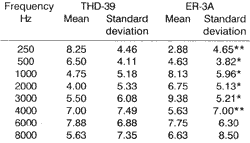
Wilcoxon Test
*p<0.05 or 5%
**p<0.01or1%
TABLE 6 - Mean values (mean and standard deviation) of corrected audibility thresholds, obtained with supra-aural TDH-39 phones and insert phones ER-3A in 20 female subjects.
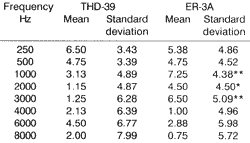
Wilcoxon lest
*p<0.05or5%
**p<0.01or1%
CHART 2 - Correction factors suggested from the hearing thresholds obtained with TDH-39 phones and insert phones ER-3A, in 40 audiologically normal subjects.

There were differences in pure tone thresholds obtained for supra-aural TDH-30 phones and insertion phones ER-3 A, and thresholds obtained with insertion phones were better for both genders.
Auditory thresholds of female subjects were better than male subjects in the evaluation of both transducers and in most situations.
Correction factors suggested by the manufacturer of insert phones ER-3 A are necessary and proved to be appropriate for this group of subjects.
REFERENCES1. BENSON, R. W; CHARAN, K. K.; DAY, J. W; HARRIS, J. D.; NIEMOELLER, A. F.; RUDMOSE, W; SHAW E. A. G.; WEISSLER, P G. - Limitations on the use of circumaural earphones. J Acoust. Soc. Am., 41(3): 713-4, 1967.
2. BERGER, E. H.; KILLION, M. C. - Comparison of the noise attenuation of three audiometric earphones with additional data on masking near threshold. J. Acoust. Soc. Am., 86(4): 1392-1402, 1989.
3. BIENVENUE, G. R. & MICHAEL, P L. -Noise attenuation characteristics of the MX-41/AR and the Telephonics circumaural audiometric headsets. J. Am. Audiol. Soc., 4(1): 1-5, 1978.
4. BORTON. T. E.; NOLEN, B. L.; LUCKS, S. B.; MELINE, N. C. - Clinical applicability of insert earphones for audiometry. Audiology, 28: 61-70, 1989.
5. CLARK, J. L. & ROES ER, R. J. -Three studies comparing performance of the ER-3A tubephone with the TDH-50P earphone. Ear Hear., 9(5): 268-74, 1988.
6. CLEMIS, J. D.; BALLAD, J. W; KILLION, M. C. - Clinical use of an insert earphone. Ann. Otol. Rhinol. Laryngol., 95: 520-4, 1986.
7. COX, R. M.; McDANIEL, M. D. - Reference equivalent threshold levels for pure-tone and 1/3 octave noise bands: insert earphone and TDH-49 earphone. J Acoust. Soc. Am., 79(2): 443-6, 1986.
8. FRANK, T. & WRIGHT, D. C. - Attenuation provided by four different audiometric earphone systems. Ear Hear., 11(1): 70-8, 1990.
9. FRANK, T. & VAVREK, M. J. - Reference threshold levels for an ER-3A insert earphone. J. Am. Acad. Audiol., 3(1): 51-9, 1992.
10. FRANK, T. & WILLIAMS, D. L. - Effects of background noise on earphone thresholds. J. Am. Acad. Audiol., 4(3): 210-12, 1993.
11. GOLDSTEIN, B. A. & NEWMAN, C. W - Clinical Masking: A Decision-Making Process. In: KATZ, J. Handbook of Clinical Audiology, 4a Ed., Baltimore, Williams and Wilkins, 1994, p.109-131.
12. HOSFORD-DUNN, H.; KUKLINSK1, A. L.; RAGGIO, M.; HAGGERTY, H. S.- Solving audiometric masking dilemmas with an insert masker. Arch. Otolaryngol. Head Neck Surg., 112:92-5, 1986.
13. KILLION, M. C. & VILLCHUR, E. - Comments on "Earphones in Audiometry". J. Acoust. Soc. Am., 85(4): 1755-78, 1988.
14. LARSON, V D.; COOPER, W A.; TALBOTT, R. E.; SCHWARTZ, D. M.; AHLSTROM, C.; DeCHICCHIS, A. R. Reference thresholds sound pressure levels for the TDH 50 and ER-3A insert earphones. J. Acoust. Soc. Am., 84(1): 46-51, 1988.
15. LILLY, D. J. & PURDY, J. K. - On the routine use of tubephone insert earphones. Am. J. Audiol., 2: 17-20, 1993. .
16. LINDGREN, F. - A comparison of the variability in thresholds measured with insert and conventional supraaural earphones. Scand. Audiol., 19(1): 19-23, 1990.
17. MANGABEIRA ALBERNAZ, E; MANGABEIRA ALBERNAZ, P L.; MANGABEIRA ALBERNAZ, L. G; MAGABEIRA ALBERNAZ, Fo. P - Otorrinolaringologia Prática, 10a edição. São Paulo, Savier, 1981.
18. MUELLER, H. G. & HALL, J. W, III - Pure tone audiometry. In: HALL, J. W, III & MUELLER, H. G. Audiologist's Desk Reference - Volume 1: Diagnostic Audiology, Principles, Procedures and Practices. Singular Publishing, San Diego, 1997, p. 78-112.
19. MUNRO, K. J. & AGNEW, N. - A comparison of interaural attenuation with the Etymotic ER-3A insert earphone and the Telephonics TDH-39 supra-aural earphone. Br. J. Audiol, 33(4): 259-62, 1999.
20. SANDERS, J. W & HALL, J. W III - Clinical Masking. In: MUSIEK, F. & RINTELMANN, W, L. - Contemporary Perspectives in Hearing Assessment. Boston, Allyn and Bacon, 1999, p. 67-87.
21. SHAW, E. A. - Ear canal pressure generated by circumaural and supra aural earphones. J. Acoust. Soc. Am., 39(3): 471-9, 1966.
22. SILMAN S. & SILVERMAN, C. A. - Basic audiologic testing: clinical masking. In SILMAN, S. & SILVERMAN, C. A. - Auditory Diagnosis: Principles and Applications. San Diego, Singular Publishing, 1997, p. 36-70.
23. STACH, B. A. - The audiologist's assessment tools: behavioral measures. In STACH, B. A. - Clinical Audiology -An Introduction, San Diego, Singular, Publishing, 1998. p. 193-256.
24. STEIN, L. & ZERLIN, S. - Effect of circumaural earphones and earphone cushions on auditory threshold. J. Acoustic. Soc. Am., 35(11): 1744-5, 1963.
25. TILLMAN, T. W & GISH, K. D. - Comments on the "Effect of Circumaural Earphones on Auditory Threshold". J. Acoust. Soc. Am., 36.: 969-70, 1963.
26. VALENTE, M.; VALENTE, M.; GOEBEL, J. - High frequency thresholds: circumaural earphone versus insert earphone. J. Am. Acad. Audiol., 3(G): 410-8, 1992.
27. VALENTE, M.; POTTS, L. G., VALENTE, M.; VASS, W; GOEBEL, J. - Intersubject variability of real ear sound pressure: conventional and insert earphones. J. Am. Acad. Audiol., 5: 590-8, 1994.
28. VALENTE, M.; POTTS, L. G.; VALENTE, M. Differences and intersubject variability of loudness discomfort levels measured in sound pressures level and hearing level for TDH-50P and ER-3A earphones. J. Am. Acad. Audiol., 8(1): 58-67, 1997.
29. WILBER, L. A.; KRUGER, B.; KILLION, M. C. Reference thresholds for the ER-3A insert earphone. J. Acoust. Soc. Am., 83(2): 669-76, 1988.
30. WILBER, L. A. - Calibration, Pure tone, Speech and Noise Signals. In KATZ, J. - Handbook of Clinical Audiology, 4a Ed., Baltimore, Williams and Wilkins, 1994, p.73-94.
31. WILBER, L. A. - Pure tone audiometry: air and bone conduction. In MUSIEK, F. E. & -RINTELMANN, W L. Contemporary Perspectives in Hearing Assessment. Boston, Allyn and Bacon, 1999, p. 1-20.
32. YANTIS, E A. - Pure tone Air Conduction Threshold Testing. In KATZ, J. - Handbook of Clinical Audiology, 4a Ed., Baltimore, Williams and Wilkins, 1994, p.97-108
33. ZWISLOCKI, J. - Acoustic attenuation between the ears. J. Acoust. Soc. Am., 25: 752-9, 1953.
34. ZWISLOCKI, J.; KRUGER, B.; MILLER, J. D.; NIEMOELLER, A. F.; SHAW E. A.; STUDEBAKER, G. Earphones in audiometry J. Acoust. Soc. Am., 83(4): 16889, 1988.
* Speech and Hearing Pathologist. Master in Human Communication Disorders, Universidade Federal de São Paulo - Escola Paulista de Medicina.
** Speech and Hearing Pathologist. Ph.D. in Human Communication Disorders, Universidade Federal de São Paulo - Escola Paulista de Medicina. Joint Professor, Discipline of Hearing Disorders, Department of Otorhinolaryngology and Human Communication Disorders UNIFESP- EPM.
Master dissertation thesis presented to Universidade Federal de São Paulo - Escola Paulista de Medicina. Study supported by grant provided by Conselho Nacional de Desenvolvimento Científico a Tecnológico-CNPq.
Address correspondence to: Daniela Gil - Rua João Escudeiro, 120-Vila Euclides -09725-490 São Bernardo do Campo/SP
Tel: (55 11) 4122-4748-E-mail: danielagil@hotmail.com
Article submitted on January 18, 2001. Article accepted on February 29. 2001.


